The Clinical Mobility Market is estimated to be valued at USD 17.8 billion in 2025 and is projected to reach USD 42.9 billion by 2035, registering a compound annual growth rate (CAGR) of 9.2% over the forecast period.
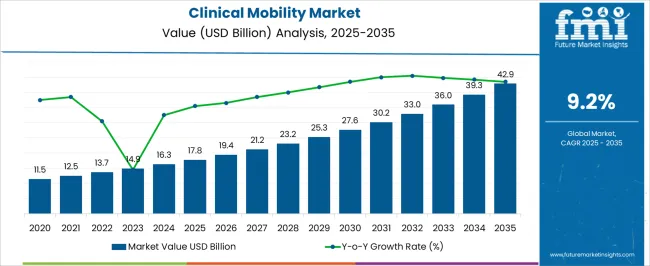
| Metric | Value |
|---|---|
| Clinical Mobility Market Estimated Value in (2025 E) | USD 17.8 billion |
| Clinical Mobility Market Forecast Value in (2035 F) | USD 42.9 billion |
| Forecast CAGR (2025 to 2035) | 9.2% |
The clinical mobility market is experiencing significant growth as healthcare systems worldwide prioritize digital transformation and seamless communication to improve patient outcomes. The adoption of mobile-enabled solutions is being accelerated by the need for real-time access to patient records, improved collaboration among care teams, and enhanced operational efficiency. Growing demand for integrated platforms that connect mobile devices, electronic health records, and clinical applications is reinforcing the market’s expansion.
Regulatory initiatives encouraging digital health adoption and investments in hospital IT infrastructure are further supporting growth. The rise of telehealth, remote monitoring, and virtual care services has also amplified reliance on mobile technologies.
The ability of clinical mobility solutions to streamline workflows, reduce errors, and enhance decision-making is driving strong acceptance across hospitals, clinics, and long-term care facilities As healthcare providers continue to seek efficiency gains and patient-centered care models, the clinical mobility market is positioned for sustained growth, with emerging technologies such as AI integration, advanced data security, and interoperability shaping the future landscape.
The clinical mobility market is segmented by product type, application, and geographic regions. By product type, clinical mobility market is divided into Mobile Devices, Products, Mobile Applications, Services, Cloud Based Services, and Web Based Services. In terms of application, clinical mobility market is classified into Patient Care, Work Force Management, and Operations. Regionally, the clinical mobility industry is classified into North America, Latin America, Western Europe, Eastern Europe, Balkan & Baltic Countries, Russia & Belarus, Central Asia, East Asia, South Asia & Pacific, and the Middle East & Africa.
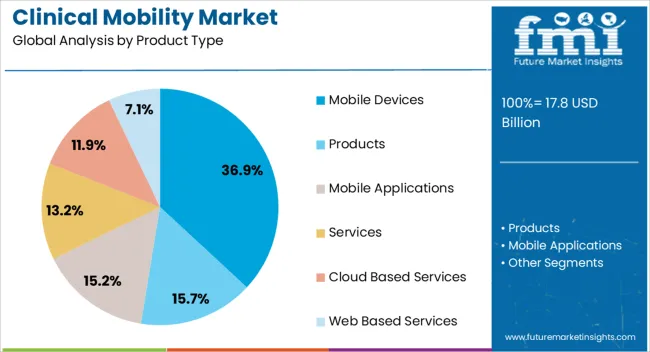
The mobile devices segment is projected to account for 36.9% of the clinical mobility market revenue share in 2025, making it the leading product type. Its dominance is being driven by the widespread integration of smartphones, tablets, and handheld devices into clinical workflows, enabling healthcare professionals to access critical patient data at the point of care. Mobile devices are providing real-time connectivity between physicians, nurses, and administrative staff, improving communication and reducing response times in emergency situations.
Their ability to support multiple applications, such as medication tracking, clinical decision support, and teleconsultations, is enhancing their value within healthcare settings. The segment’s growth is further reinforced by rising investments in secure mobile platforms that comply with healthcare data protection regulations.
Cost efficiency, portability, and ease of integration with existing hospital systems are also key contributors to its widespread adoption As hospitals increasingly prioritize mobility-driven care delivery models, mobile devices are expected to remain central to clinical operations, solidifying their leadership position in the market.
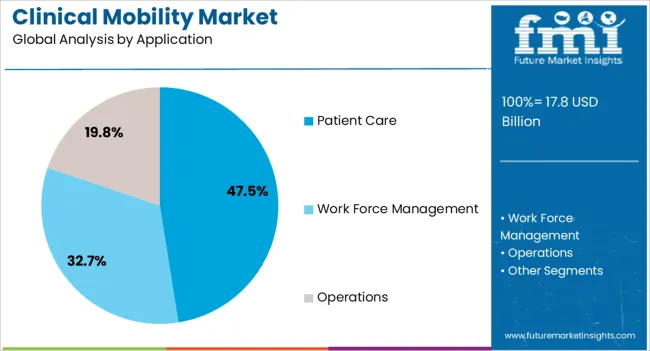
The patient care segment is expected to represent 47.5% of the clinical mobility market revenue share in 2025, establishing itself as the leading application area. Its prominence is being reinforced by the increasing emphasis on improving patient engagement, safety, and treatment outcomes through mobility-enabled solutions. Clinical mobility is being leveraged to provide real-time monitoring, accurate medication administration, and faster communication between patients and caregivers.
The segment’s growth is being supported by the integration of mobile tools into bedside care, allowing healthcare professionals to document and access patient information seamlessly, reducing errors and improving workflow efficiency. The adoption of secure messaging and mobile-enabled monitoring systems is further enhancing care coordination.
As hospitals and healthcare facilities focus on personalized care delivery, the ability of clinical mobility solutions to empower both patients and providers with timely information is proving essential With patient-centric models becoming a priority across global healthcare systems, the patient care segment is expected to sustain its leadership in driving market expansion.
Technological advancements and innovations in the health care industry enables create lucrative opportunities for the companies which are plunged in clinical mobility market. The clinical mobility enhances information flow among the health care providers and patients.
Most of the patients face problems retaining information. Clinicians can use mobile health devices to supplement the information as well as mobile application are designed to provide in- depth therapeutic and diseases specific information. The patients can easily search the disease related information.
The clinical mobility offers a wide array of advantages, includes telemonitoring, vital signs of geriatric patients, and video conference with care givers and doctors. Software-as-a-Services (SaaS), Platform-as-a-Services (Paas) is gaining the popularity due to enormous advantages in clinical mobility.
Smartphones are acts as a universal devices on which various application can be integrated. Visibility solutions enables doctors and nurses to provide the better services to the patients. The global clinical mobility market anticipated to exhibit a significant CAGR as well as annual growth rate over the forecast period.
Clinical mobility market can be impacted by following factors, change the trend towards technological advancements and innovations in the health care industry enables increase adoption rate of mobile devices, which proliferate the global clinical mobility market.
Increase in the health care expenditure enable adopt advanced technologies such as clinical mobile services and Information technology related services i.e., electronic health records spur the new opportunities for the clinical mobility market. The governments are taking initiative steps to generate and adopt the advanced clinical mobility services have a tremendous impact on clinical mobility market.
However, dearth of skilled professional and cost are act as bottlenecks for global clinical mobility market.
Global clinical mobility market is gaining up surge across the globe due to increased awareness among people. The global clinical mobility market is witnessed to unlock the potential over the forecast period.
Global market is segmented into seven key regions, those are North America (N.A), Latin America (L.A), Eastern Europe (E.E), Western Europe (W.E), Asia-Pacific Excluding Japan (APEJ), Middle East and Africa (MEA), and Japan.
North America is maintaining its stewardship in clinical mobility market due to increased awareness as well as adoption of advanced technologies in health care sector. USA, Canada has a significant contribution in the global clinical mobility market.
Europe is expected to exhibit a robust growth, owing to increased adoption of advanced technologies. Germany has a significant contribution in European region followed by UK, Italy, and Belgium. Asia-Pacific region offers a robust market share in global clinical mobility market, owing to the drastic change in Asian countries demographics as well as economy industry in China, Japan, and India.
The global clinical mobility market is anticipated to account for significant CAGR as well as lucrative opportunities for the companies over the forecast period.
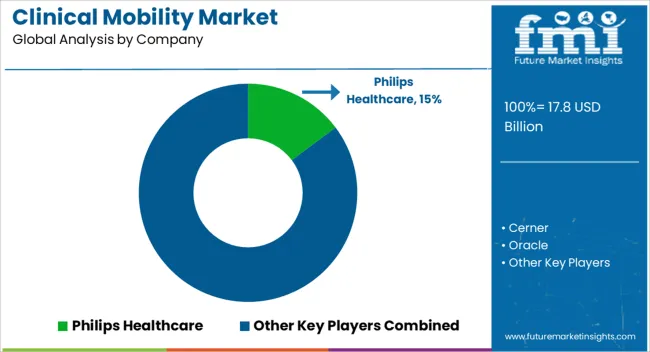
Some of the key players are Philips Healthcare, Cerner Corporation, Oracle Corporation, AT&T Inc., Cisco Systems, Inc., Zebra Technologies Corporation, Omron Corporation , and Airstrip Technologies, Inc. Microsoft, Inc. Apple, Inc. IBM Corporation, and Verizon Communications, Inc.
The Research report presents a comprehensive assessment of the market and contains thoughtful insights, facts, historical data, and statistically supported and industry-validated market data. It also contains projections using a suitable set of assumptions and methodologies. The research report provides analysis and information according to categories such as market segments, geographies, types, technology and applications.
The report is a compilation of first-hand information, qualitative and quantitative assessment by industry analysts, inputs from industry experts and industry participants across the value chain. The report provides in-depth analysis of parent market trends, macro-economic indicators and governing factors along with market attractiveness as per segments. The report also maps the qualitative impact of various market factors on market segments and geographies.
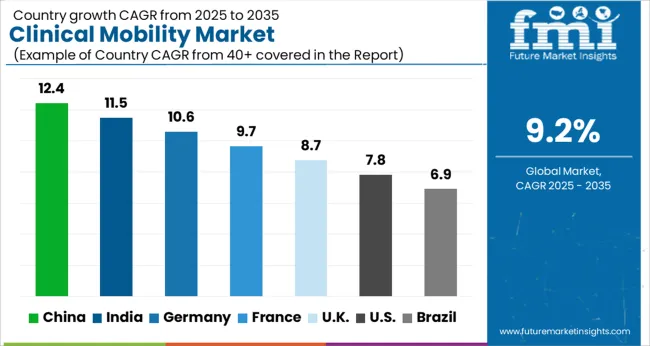
| Country | CAGR |
|---|---|
| China | 12.4% |
| India | 11.5% |
| Germany | 10.6% |
| France | 9.7% |
| UK | 8.7% |
| USA | 7.8% |
| Brazil | 6.9% |
The Clinical Mobility Market is expected to register a CAGR of 9.2% during the forecast period, exhibiting varied country level momentum. China leads with the highest CAGR of 12.4%, followed by India at 11.5%. Developed markets such as Germany, France, and the UK continue to expand steadily, while the USA is likely to grow at consistent rates. Brazil posts the lowest CAGR at 6.9%, yet still underscores a broadly positive trajectory for the global Clinical Mobility Market. In 2024, Germany held a dominant revenue in the Western Europe market and is expected to grow with a CAGR of 10.6%. The USA Clinical Mobility Market is estimated to be valued at USD 6.7 billion in 2025 and is anticipated to reach a valuation of USD 14.3 billion by 2035. Sales are projected to rise at a CAGR of 7.8% over the forecast period between 2025 and 2035. While Japan and South Korea markets are estimated to be valued at USD 849.4 million and USD 535.6 million respectively in 2025.
| Item | Value |
|---|---|
| Quantitative Units | USD 17.8 Billion |
| Product Type | Mobile Devices, Products, Mobile Applications, Services, Cloud Based Services, and Web Based Services |
| Application | Patient Care, Work Force Management, and Operations |
| Regions Covered | North America, Europe, Asia-Pacific, Latin America, Middle East & Africa |
| Country Covered | United States, Canada, Germany, France, United Kingdom, China, Japan, India, Brazil, South Africa |
| Key Companies Profiled | Philips Healthcare, Cerner, Oracle, AT&T, Cisco Systems, Zebra Technologies, Omron, Airstrip Technologies, Microsoft, Apple, IBM, and Verizon Communications |
The global clinical mobility market is estimated to be valued at USD 17.8 billion in 2025.
The market size for the clinical mobility market is projected to reach USD 42.9 billion by 2035.
The clinical mobility market is expected to grow at a 9.2% CAGR between 2025 and 2035.
The key product types in clinical mobility market are mobile devices, products, mobile applications, services, cloud based services and web based services.
In terms of application, patient care segment to command 47.5% share in the clinical mobility market in 2025.






Our Research Products

The "Full Research Suite" delivers actionable market intel, deep dives on markets or technologies, so clients act faster, cut risk, and unlock growth.

The Leaderboard benchmarks and ranks top vendors, classifying them as Established Leaders, Leading Challengers, or Disruptors & Challengers.

Locates where complements amplify value and substitutes erode it, forecasting net impact by horizon

We deliver granular, decision-grade intel: market sizing, 5-year forecasts, pricing, adoption, usage, revenue, and operational KPIs—plus competitor tracking, regulation, and value chains—across 60 countries broadly.

Spot the shifts before they hit your P&L. We track inflection points, adoption curves, pricing moves, and ecosystem plays to show where demand is heading, why it is changing, and what to do next across high-growth markets and disruptive tech

Real-time reads of user behavior. We track shifting priorities, perceptions of today’s and next-gen services, and provider experience, then pace how fast tech moves from trial to adoption, blending buyer, consumer, and channel inputs with social signals (#WhySwitch, #UX).

Partner with our analyst team to build a custom report designed around your business priorities. From analysing market trends to assessing competitors or crafting bespoke datasets, we tailor insights to your needs.
Supplier Intelligence
Discovery & Profiling
Capacity & Footprint
Performance & Risk
Compliance & Governance
Commercial Readiness
Who Supplies Whom
Scorecards & Shortlists
Playbooks & Docs
Category Intelligence
Definition & Scope
Demand & Use Cases
Cost Drivers
Market Structure
Supply Chain Map
Trade & Policy
Operating Norms
Deliverables
Buyer Intelligence
Account Basics
Spend & Scope
Procurement Model
Vendor Requirements
Terms & Policies
Entry Strategy
Pain Points & Triggers
Outputs
Pricing Analysis
Benchmarks
Trends
Should-Cost
Indexation
Landed Cost
Commercial Terms
Deliverables
Brand Analysis
Positioning & Value Prop
Share & Presence
Customer Evidence
Go-to-Market
Digital & Reputation
Compliance & Trust
KPIs & Gaps
Outputs
Full Research Suite comprises of:
Market outlook & trends analysis
Interviews & case studies
Strategic recommendations
Vendor profiles & capabilities analysis
5-year forecasts
8 regions and 60+ country-level data splits
Market segment data splits
12 months of continuous data updates
DELIVERED AS:
PDF EXCEL ONLINE
Clinical Trial Data Management Service Market Size and Share Forecast Outlook 2025 to 2035
Clinical Trial Biorepository & Archiving Solution Market Size and Share Forecast Outlook 2025 to 2035
Clinical Chairs Market Size and Share Forecast Outlook 2025 to 2035
Clinical Avian Nutrition Market Analysis - Size, Share, and Forecast Outlook 2025 to 2035
Clinical Workflow Solution Market Size and Share Forecast Outlook 2025 to 2035
Clinical Trials Support Software Solutions Market Size and Share Forecast Outlook 2025 to 2035
Clinical Research Organization Market Size and Share Forecast Outlook 2025 to 2035
Clinical Trial Packaging Market Size and Share Forecast Outlook 2025 to 2035
Mobility On Demand (MOD) Market Size and Share Forecast Outlook 2025 to 2035
Clinical Immunodiagnostics Market Size and Share Forecast Outlook 2025 to 2035
Clinical Communication and Collaboration Market Size and Share Forecast Outlook 2025 to 2035
Clinical Oncology Next-generation Sequencing Market Analysis - Size, Share, and Forecast 2025 to 2035
Clinical Decision Support Systems Market Size and Share Forecast Outlook 2025 to 2035
Clinical Trials Market Analysis - Size, Share, and Forecast 2025 to 2035
Clinical Refractometer Market Size and Share Forecast Outlook 2025 to 2035
Clinical Next-Generation Sequencing (NGS) Data Analysis Market Analysis by Solution and Services, Technology, End User, and Region through 2035
Mobility as a Service Market - Demand & Growth Forecast 2025 to 2035
Clinical Hand Hygiene Products Market – Trends, Growth & Forecast 2025 to 2035
The Clinical Alarm Management Market is segmented by component, deployment mode and end user from 2025 to 2035
Clinical Nutrition Market Insights – Trends & Forecast 2025 to 2035

Thank you!
You will receive an email from our Business Development Manager. Please be sure to check your SPAM/JUNK folder too.
Chat With
MaRIA